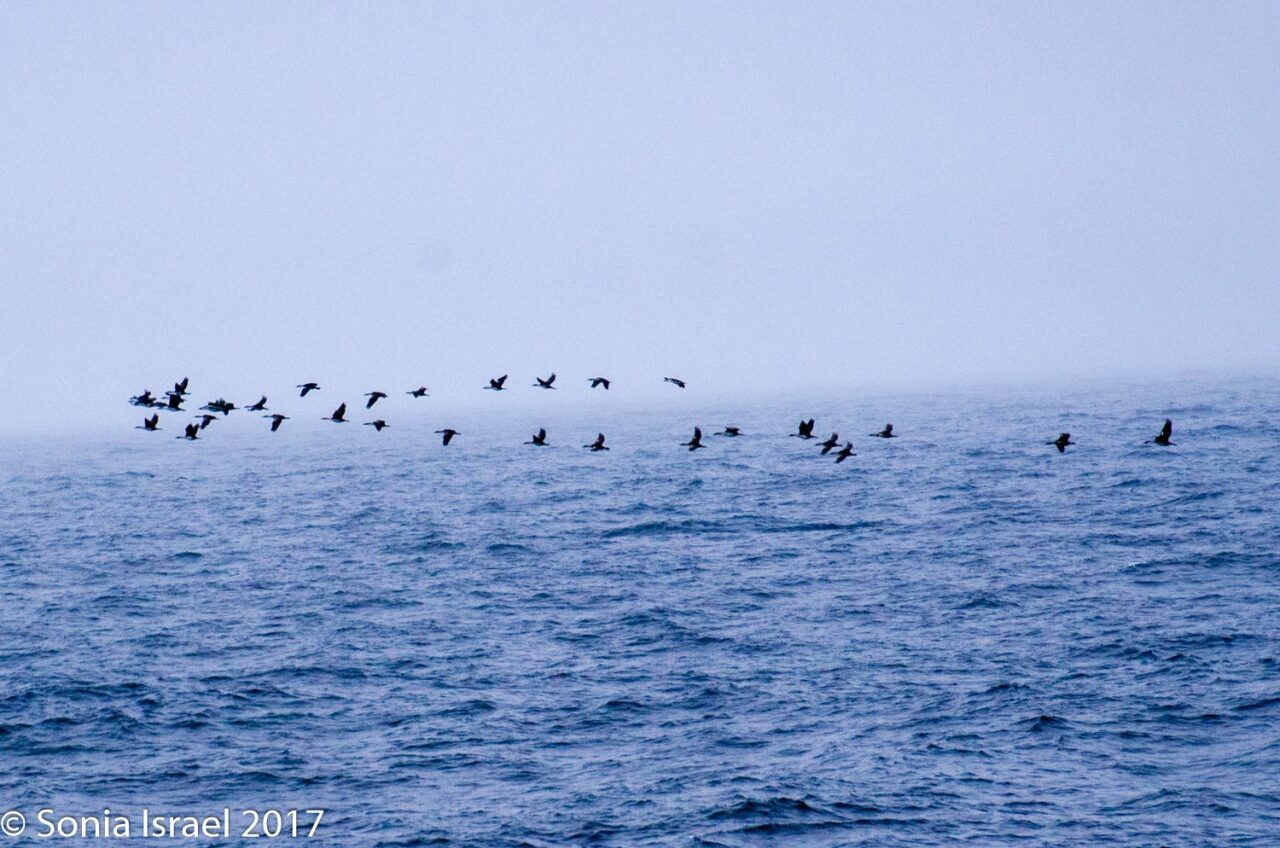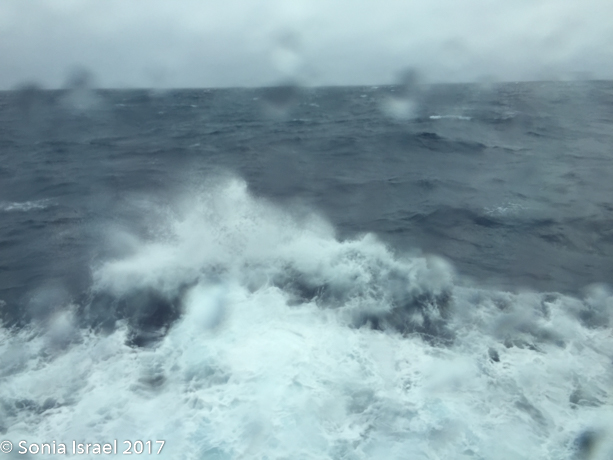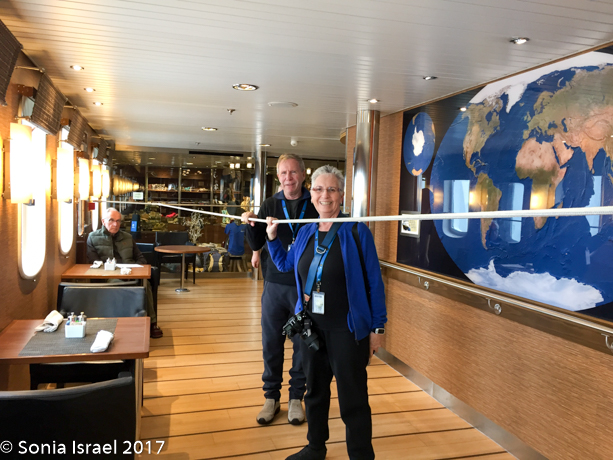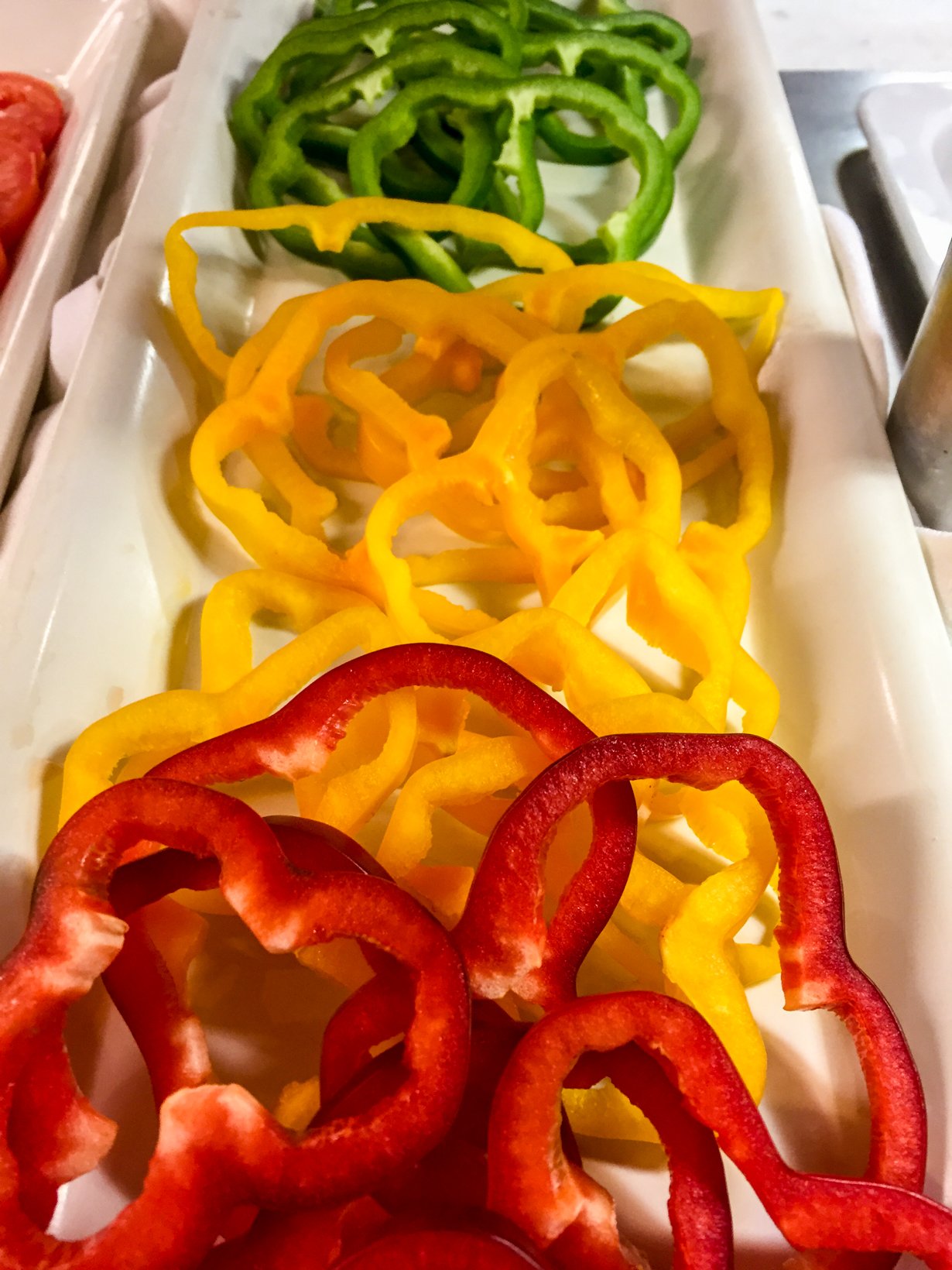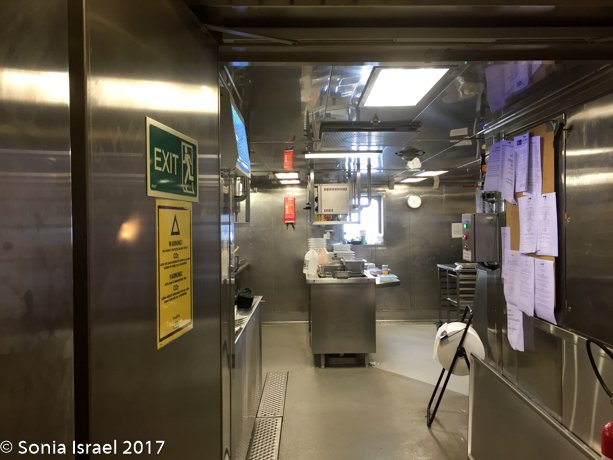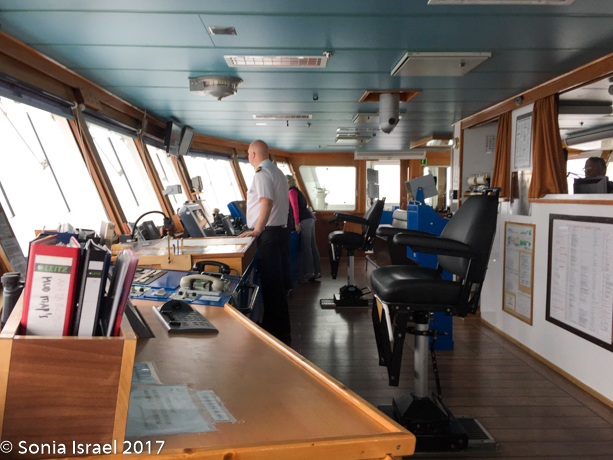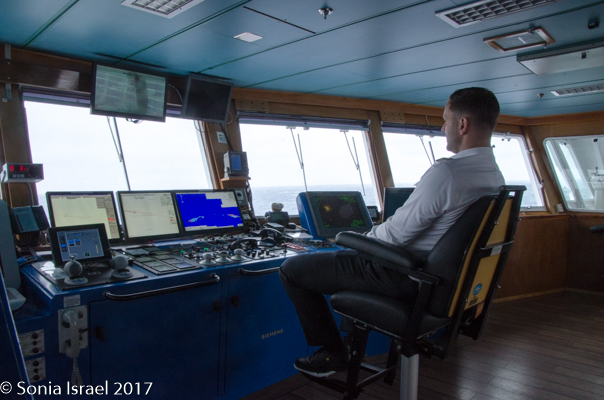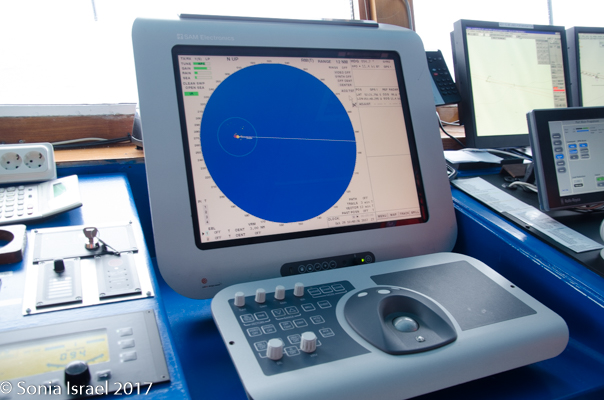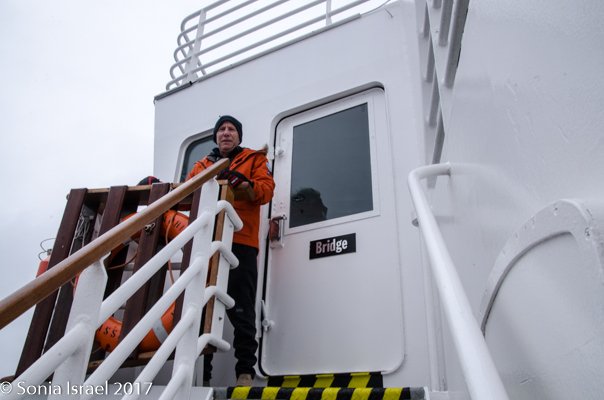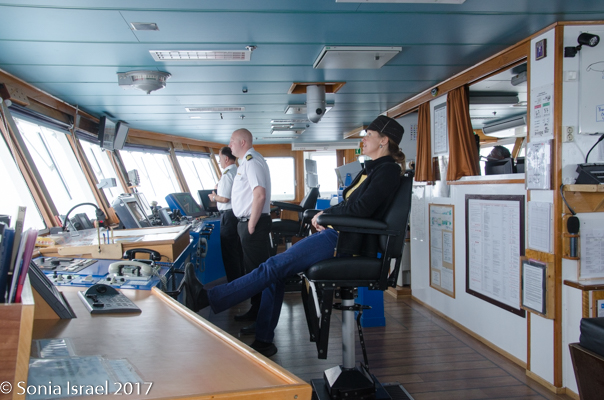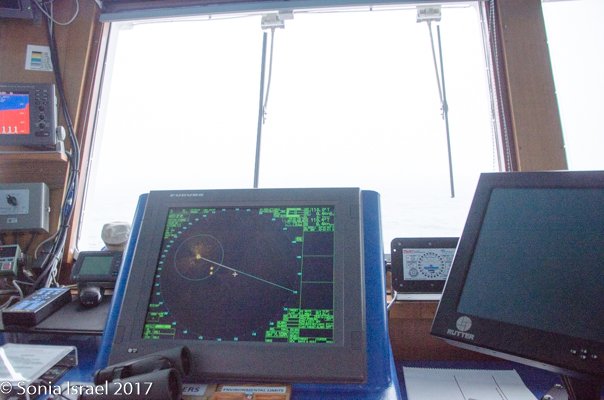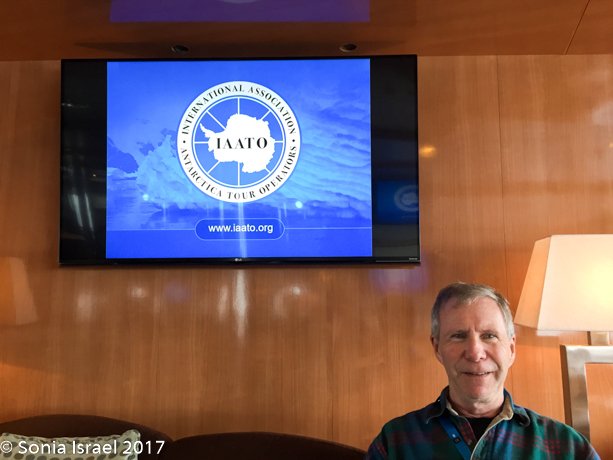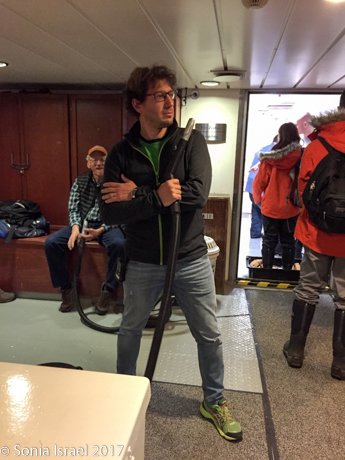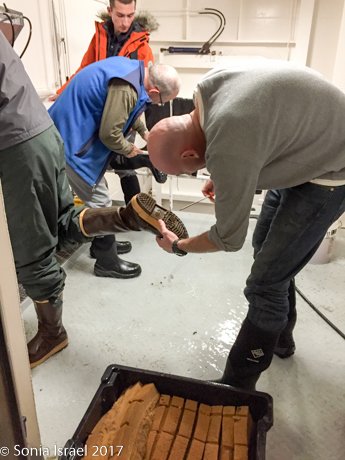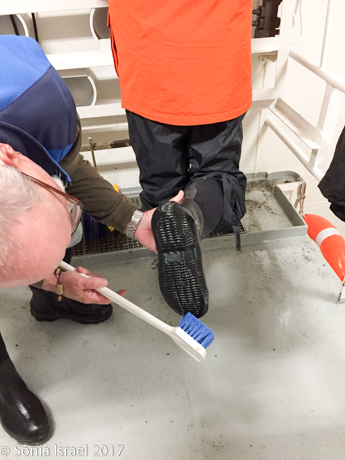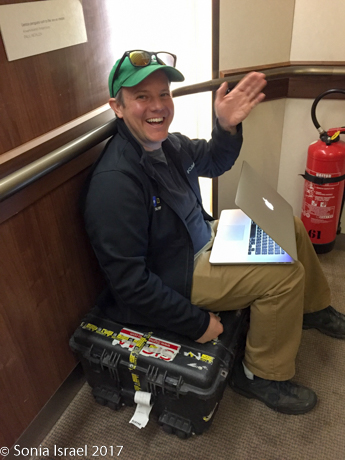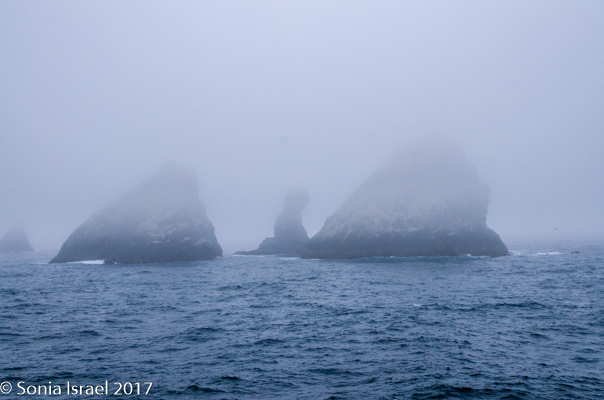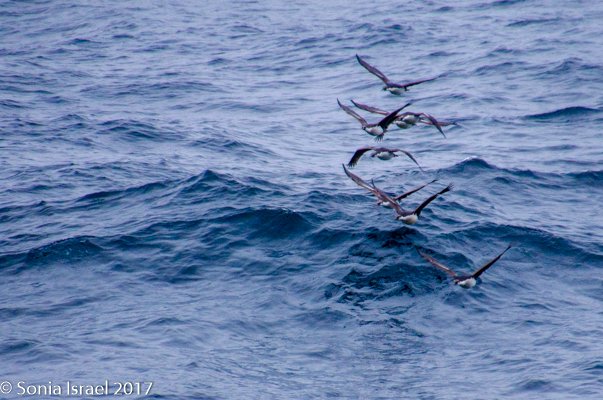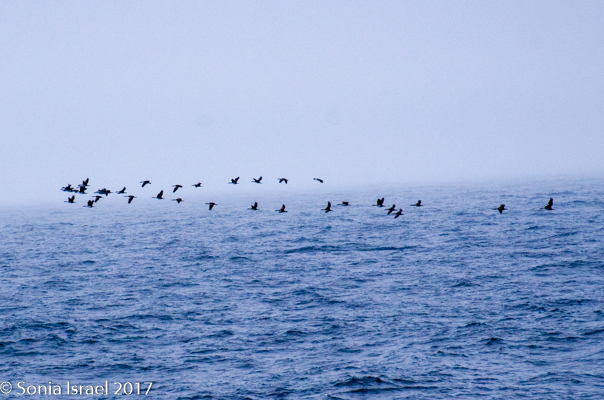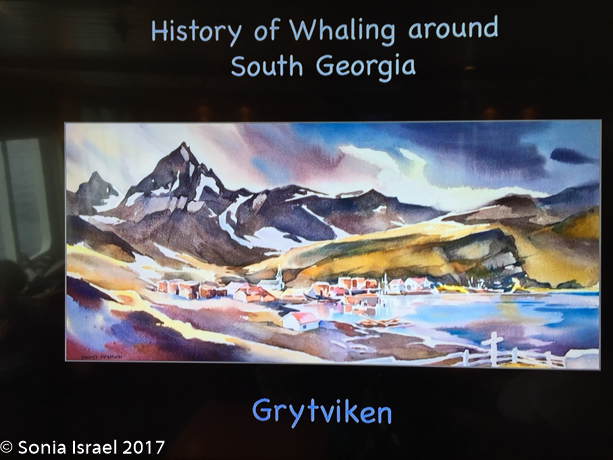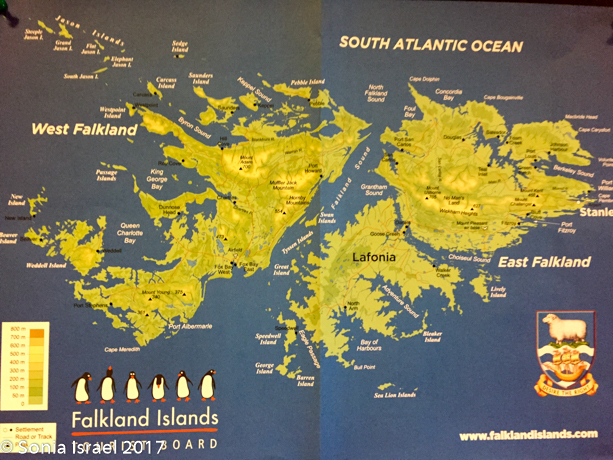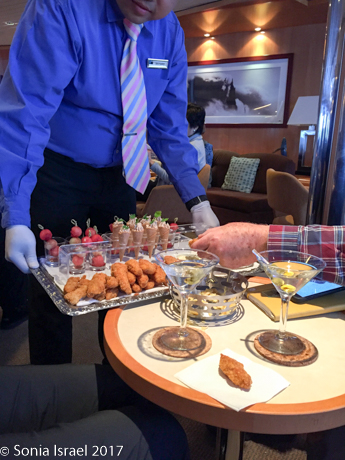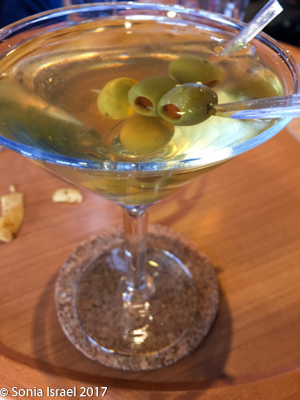Sunday-Monday, October 29-30, 2017
Rock ‘n Roll
Last night, ropes suddenly appeared all along the halls of the ship. Something to 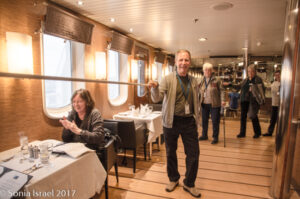 hold on to. The chairs were already tied down, and the silverware was placed inside the napkins. And as we left Stanley and hit the open waters, the ship began “rockin ‘n rollin.” Literally. Rocking. Rolling.
hold on to. The chairs were already tied down, and the silverware was placed inside the napkins. And as we left Stanley and hit the open waters, the ship began “rockin ‘n rollin.” Literally. Rocking. Rolling.
Some of our fellow passengers turned a bit green. But Andy and I were OK. After dinner we made our way to the lounge for a showing of Chapter 1 of “Chasing Shackleton.” This is the epic tale of leadership, heroism and sheer determination of Tim Jarvis and four other men who set out to relive Shackleton’s miraculous crossing of the Southern Ocean from Elephant Island to South Georgia. Shackleton did it to try to save his men. Tim Jarvis and his men did it to see if they could. They built a small wooden boat just like Shackleton’s. They wore clothes just like him. They had no GPS or modern tools (they did have another boat following them as that is a law in the Antarctic waters). But they were cold, and tired and being thrown around by the waves and the storms. It was fascinating to watch as we were also crossing the same waters. We too were being tossed around, but we got to go down to our warm beds.
Day at Sea
Today is a day at sea as we head towards South Georgia. We will spend two days crossing the 700 nautical miles of the Southern Ocean, known as the Scotia Sea. As it said in our daily bulletin, “Seabirds and marine mammals call this home and have thrived in the productive storm plagued waters for millions of years. The very fact that this body of water exists, isolating South Georgia, is what draws people to its shores.” But this is also one of the roughest oceans, thus the ropes around the ship, people pasted on their patches to prevent sea-sickness and the trip across the ocean commenced. When I looked out my window, the glass was covered in water drops and the 40-foot swells could be clearly seen.
Antarctic Convergence
We were sailing towards the Antarctic Convergence, also called the Polar Front. This is a front is formed by the meeting of cold, dense and mostly non-saline waters flowing up from Antarctica and warmer, more saline waters coming south from the tropics. These conflicting currents clash, converge and sink. This mixing of waters provides a nourishing environment for seabirds and sea mammals. Our daily program said that this area is sometimes marked by a belt of fog or mist. The captain joked about us feeling a bump as we crossed it.
One thinks of days at sea as long and boring. Nothing to see but the ocean. Nothing to do but relax on deck reading a book. Not so in South Georgia and the Southern or Scotia Sea. Starting with breakfast, the day continued full of talks.
Breakfast on board the MS National Geographic Explorer
Maybe I should stop here for a moment to talk about breakfast. Breakfast was always a buffet with cheese, meats, tomatoes, cucumbers, bell peppers (all from Stanley from the Stanley Growers we visited), fresh fruit (while it lasts), oatmeal with fixings, yogurts, scrambled eggs, omelets to order and either French toast, pancakes or some other specialty. Breads were delicious and abundant. Jams. Peanut butter. Anything your heart might desire. As each day passed, I tried to eat a bit less as the amount of food I was consuming was getting a bit crazy.
- Kitchen
Seabirds of the Southern Ocean
After breakfast, Bud Lehnhausen tried again to give his talk on Seabirds of the Southern Ocean as yesterday’s was interrupted by whale sightings, this time a killer whale. We ran up to the bridge to watch. He swam back and forth in front of the ship, never quite breeching, but coming up enough that we could see him.
When we finally got back to the lecture, we learned that we will see lots of birds in the next few days. The Gray-headed albatross (also call the Light Mantled Albatross and who have big eyes that look like they are always surprised). Giant Petrels (also called stinkers because as a defense response they regurgitate rich oily stinky substance). Northern giant petrel (with a reddish tip on the bill). Southern giant petrel (which a green tip on the bill). Brown skuas (who are scavengers and are very vocal and aggressive, especially if a vulture is near its nest). Shags. Antarctic Terns (which are white with a red head and a yellow bill, with thin wings that flap frantically; they migrate from artic to Antarctica). And the South Georgia Pipit (a song bird found all year round in South Georgia now that the rats are gone – see below).
King Penguins
And of course penguins. Lots of and lots of King penguins and Gentoo penguins. King penguins, of which we would see hundreds of thousands, stand about 3 feet high and weigh about 30 pounds. There are 600,000 breeding pairs in the world, with the largest population on South Georgia. Their breeding cycle is long, lasting 13-15 months. And they are deep divers, diving up to about 900 feet. The breeding habit is quite unusual as they breed two out of every three years. If they breed two years in a row, they take off the third year. Their eggs are laid in October and hatch in December. And the chicks make such a racket. In the winter, the chicks might be left alone, with no food, for 4-5 months. So all the chicks huddle together in what is called a crèche, keeping each other warm. In South Georgia, food is more plentiful, so the chicks might get fed more often. And as with everything, it is all about survival of fittest, with the strongest chicks in center of the crèche and the weaker ones on outside. And how do the parents find their chick in that huge crèche of baby penguins? It is all about their voice. Penguins have a split vocal box and each penguin has its own individual sound. While all those screaming chicks sound the same to us, the parents recognize their own baby.
Pen gwyn
And why are penguins called penguins? Pen gwyn means white head. Pinguinus is the great auk which is now extinct. The penguins were likely mistaken for the great auk by sailors who named these new birds penguins.
Greg Marshall and the Crittercam
But one of the most interesting talks was by Greg Marshall, the inventor, biologist and Emmy Award winning filmmaker who has dedicated his life to studying, exploring and documenting animal life. He invented the crittercam, a small, lightweight camera that is attached to the back of all sorts of animals including whales, penguins, lions, dolphins etc etc, which allow us for the first time to unobtrusively have an intimate look at their lives from their perspective. Sort of like a Go Pro for animals. Greg in fact, joked that he could have made millions if he had thought of applying his technology to humans!
IAATO – International Association of Antarctica Tour Operators
We also had a mandatory IAATO lecture on how to make sure we don’t bring any seeds or other contaminants onto South Georgia. As with the life boat drill, Doug took a roll call to be sure each cabin was present. We had to have anything that had been out in the Falklands such as boots, anything with Velcro, cuffs in pants, examined, cleaned and disinfected. And each time we would leave or enter the ship, we would step through disinfectant.
The main reason for this is that in the past South Georgia was infested with rats, probably brought back in 1774 by Captain Cook, the first to discover South Georgia. South Georgia has no trees and is covered in tussock grass, low to the ground. That is where all the birds nest. So it was easy for the rats to get at the eggs and baby birds. One of the birds most badly hit was the South Georgia Pipit, which lost 70% of its habitat. There has been a concerted effort since 2011 to eradicate the rats, and it seems to have been successful. One way to know is that the Pipit has returned. But they are still checking to be sure there are no more rats and they are very careful as to what other contaminants might be brought by innocent visitors like us.
Shag Rocks
At some point, we passed Shag Rocks, six small islands that lie 150 miles west of South Georgia. These islands are home to South Georgia shags, prions and the wandering albatross. But they were covered in fog as we sailed by. Nevertheless, after we passed them and could only see them in the distance, the sky was suddenly filled with birds, flying in formation, flying all over the place, and almost darkening the sky. They must have been off looking for food to bring back to the rocks.
Cocktails and Daily Briefing
Each evening we would all meet in the lounge for drinks, hors d’oeuvres, a recap of the day, a briefing on what the next day would bring and a talk relevant to our trip. This was a time to visit with new friends, relax and enjoy the views outside the large windows. A great way to end each day.
